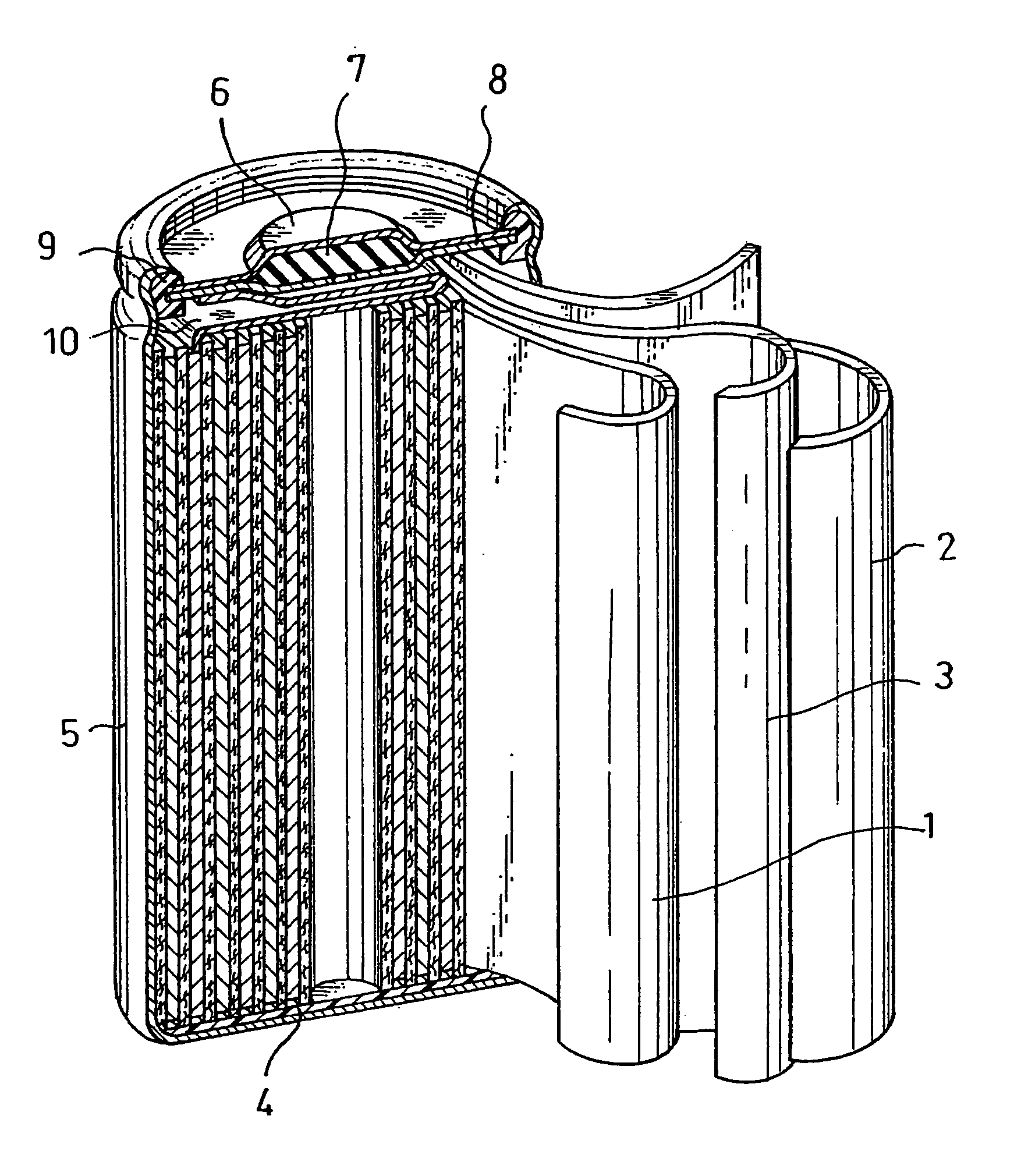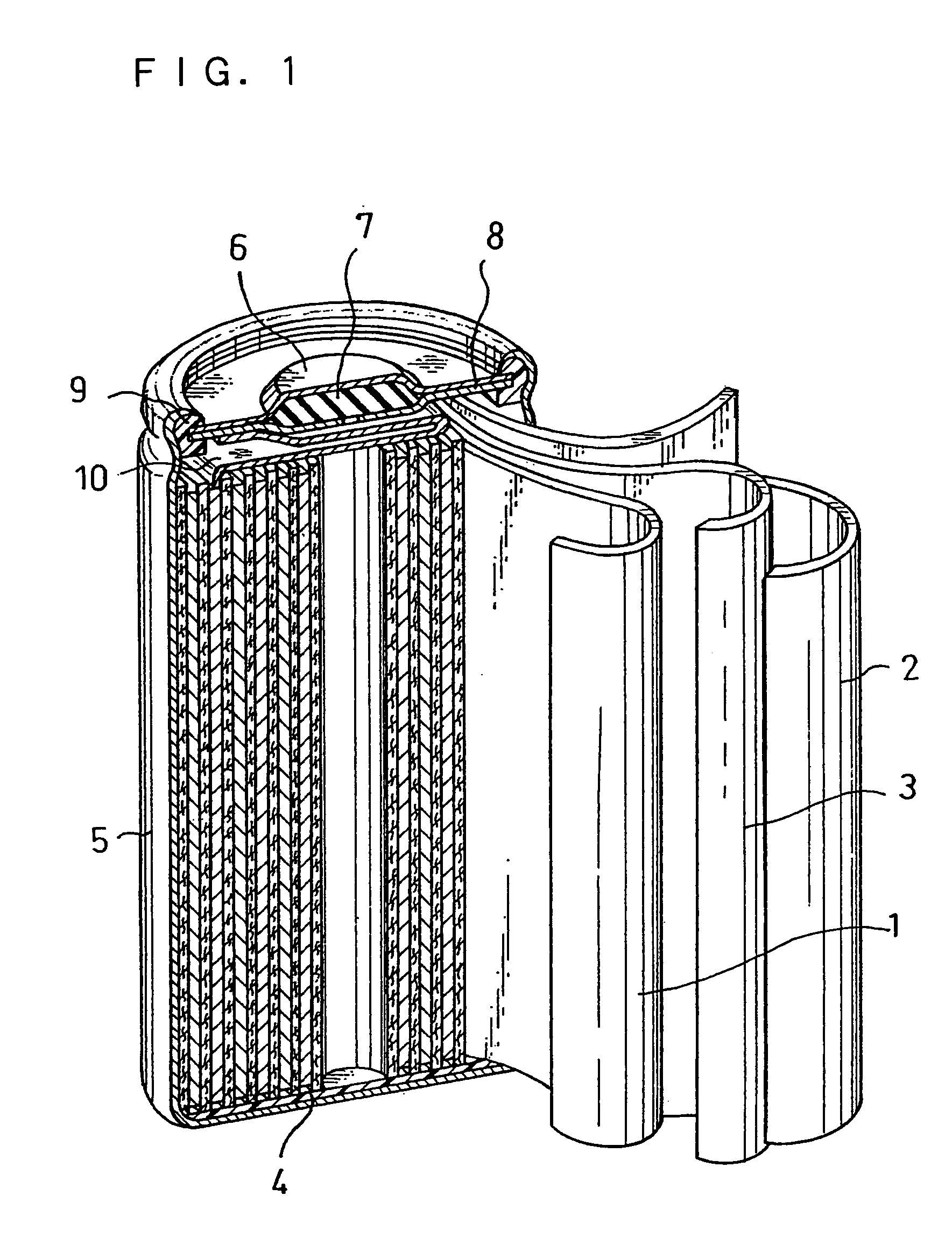Alkaline storage battery and method for producing the same
a technology of alkaline storage batteries and methods, applied in the direction of nickel accumulators, cell components, sustainable manufacturing/processing, etc., can solve the problems of negative electrodes, insufficient prevention techniques, failure to solve the problems caused by elements, etc., and achieve the effect of low cost and easy handling
- Summary
- Abstract
- Description
- Claims
- Application Information
AI Technical Summary
Benefits of technology
Problems solved by technology
Method used
Image
Examples
example 1
(i) Positive Electrode Preparation
[0083] A carbonyl nickel powder (#255, manufactured by Inco Limited.) was dispersed in an aqueous solution containing 1% by weight of methyl cellulose, to form a slurry with a solid content of 35% by weight. The slurry was applied onto a surface of a metal substrate such that the weight density of the nickel powder after sintering would become 50 g / m2. The metal substrate was a nickel foil with a thickness of 20 μm and a weight density of 170 g / m2, produced by electrolytic plating.
[0084] Subsequently, the nickel foil with the slurry was dried to evaporate its water content, and was then sintered in a hydrogen reducing atmosphere containing steam at 950° C. for 15 minutes. As a result, the organic matter contained in the slurry was removed, so that a sintered body of nickel foil and nickel powder (hereinafter referred to as a “sintered nickel substrate”) was obtained.
[0085] The sintered nickel substrate was cut in matrix form to make 2-mm-long sl...
example 2
(i) Battery Production
[0106] A sealed battery with a nominal capacity of 6000 mAh in the initial state was produced in the same manner as in Example 1, except for the use of carbon fluoride (CF1.0) with a mean particle size (median diameter D50) of 0.2 μm, instead of polytetrafluoroethylene, in the preparation of a separator layer.
[0107] Batteries made with zinc oxide, iron oxide, magnesium oxide, manganese oxide, aluminum oxide, chromium oxide, vanadium oxide, titanium oxide, and cobalt oxide as the oxygen-containing metal compound were named Example batteries C-1, C-2, C-3, C-4, C-5, C-6, C-7, C-8 and C-9, respectively.
(ii) Battery Evaluation
[0108] The batteries C-1 to C-9 were evaluated in the same manner as in Example 1. Table 2 shows the results.
TABLE 2Remaining capacity rate (%)After 15000BatteryOxideInitial statecyclesC-1Zinc oxide92.389.3C-2Iron oxide92.488.6C-3Magnesium oxide92.189.3C-4Manganese oxide92.287.7C-5Aluminum oxide92.388.3C-6Chromium oxide92.189.3C-7Vanad...
example 3
(i) Separator Layer (Polymer Sheet) Preparation
[0109] 10 g of cross-linked potassium polyacrylate (water-absorbing polymer) was mixed with 125 g of an aqueous potassium hydroxide solution with a specific gravity of 1.25 g / ml (alkaline aqueous solution), 0.2 g of carboxymethyl cellulose (binder), 6.75 g of polytetrafluoroethylene powder with a mean particle size (median diameter D50) of 0.1 μm (water repellent), and 0.5 g of a predetermined oxide with a mean particle size (median diameter D50) of 1 μm (oxygen-containing metal compound) to form a gel.
[0110] The gel was impregnated into a polypropylene non-woven fabric used in Comparative Example 1, and then dried. In this way, a polymer sheet with a thickness of 80 μm was obtained.
[0111] The air permeability of the resultant polymer sheet was approximately 18 ml / cm2·s at a pressure difference of 124 Pa.
(ii) Battery Production
[0112] A sealed battery with a nominal capacity of 6000 mAh in the initial state was produced in the sam...
PUM
| Property | Measurement | Unit |
|---|---|---|
| thickness | aaaaa | aaaaa |
| particle size | aaaaa | aaaaa |
| mean particle size | aaaaa | aaaaa |
Abstract
Description
Claims
Application Information
 Login to View More
Login to View More - R&D
- Intellectual Property
- Life Sciences
- Materials
- Tech Scout
- Unparalleled Data Quality
- Higher Quality Content
- 60% Fewer Hallucinations
Browse by: Latest US Patents, China's latest patents, Technical Efficacy Thesaurus, Application Domain, Technology Topic, Popular Technical Reports.
© 2025 PatSnap. All rights reserved.Legal|Privacy policy|Modern Slavery Act Transparency Statement|Sitemap|About US| Contact US: help@patsnap.com


